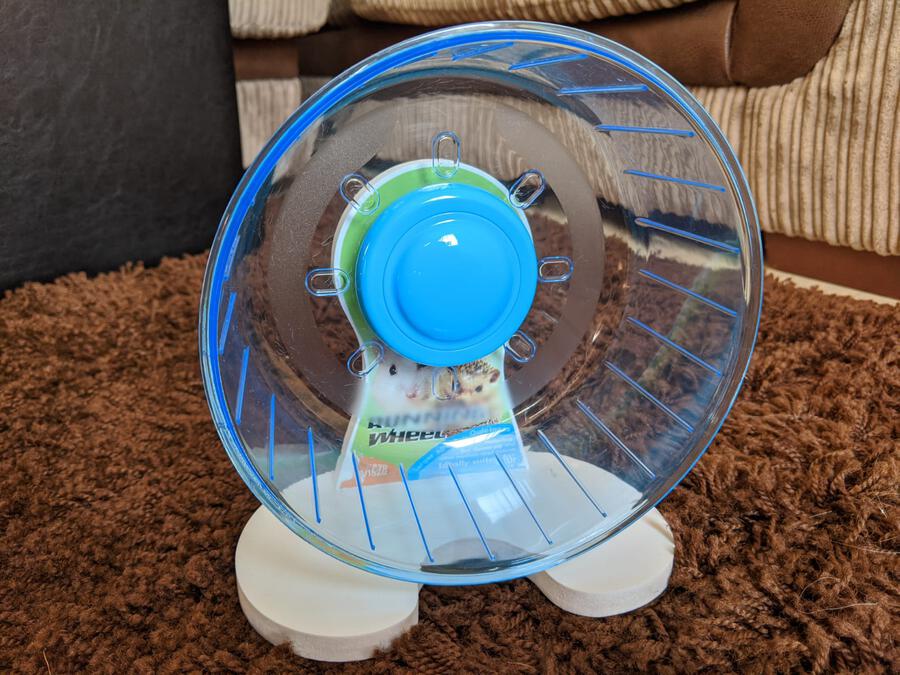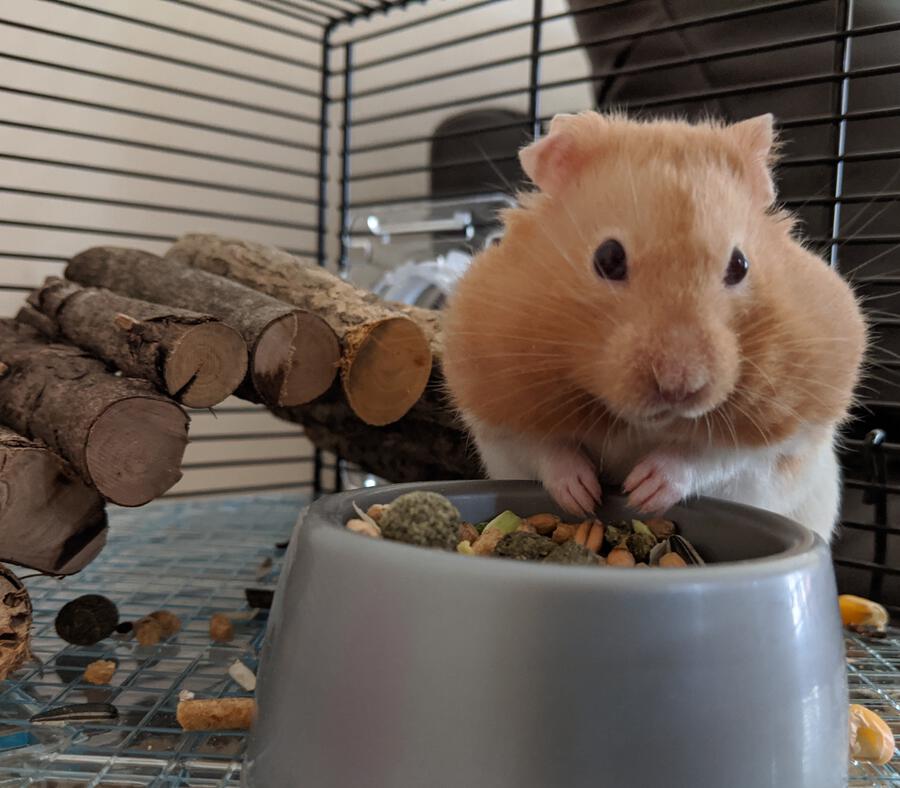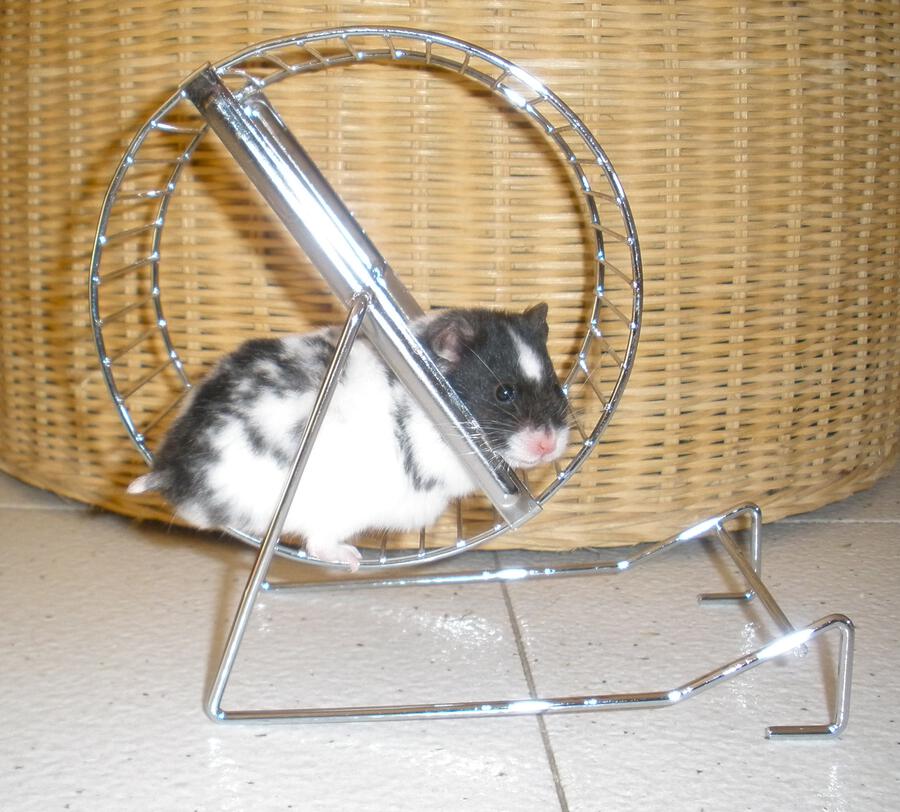Hamsters are very clean animals and rarely smell or look dirty because they are constantly grooming themselves to keep their beautiful coats nice and clean.
Having said that, some of the things that they do can seem disgusting.
One of those things is peeing on their wheels! I haven’t had an issue personally with our Syrian doing this, but other pet owners do have this issue and many have reported this on the forums like here and here.
So how can you stop this behavior?
Well, it is actually possible to potty train your hamster. I have outlined the steps below on how to do this so, if you want to cut to the chase, click here to go to the section below.
First of all though, let’s look at a couple of reasons why your hamster might be peeing on their wheel in the first place.
Table of Contents
Why your hamster is peeing in their wheel
What you have to remember is that hamsters were once wild and have retained some of their behavioural instincts. Some of these behavioural instincts may be disgusting to us, but several species of hamsters use urine to denote their territory.
Therefore if your hamster is peeing in their wheel, it could be to do with marking their territory and by peeing in their wheel, they are claiming that wheel as their own.
Of course there is a chance that your hamster may be peeing on his wheel just because they like the texture of it or simply that because that’s where they like to pee.

Either way, you need to train your hamster to pee somewhere else, because cleaning your hamster wheel every time your hamster pees on it will quickly get monotonous.
Also the more you clean the wheel, the more it will encourage your hamster pee in their wheel to keep up the scent.
So, with that in mind let’s look at how you can stop your hamster peeing in their wheel by training your hamster to use a litter box.
Training your hamster to use a litter box
The first thing that you need to do do is clean your hamster cage. It’s important that when you do this that you use a pet safe disinfectant to remove all pee odours, such as this one (Amazon, #CommissionsEarned).
The next step is to get a hamster potty. The best ones are those that fit snugly into a corner because that’s where hamsters prefer to go.
If you’re reading this and your hamster not only pees on his wheel but also in a corner, then choose the corner that your hamster likes to go in.
If you can get one with a roof that’s even better because it will make your hamster feel more secure. A hamster potty like this one from Amazon (#CommissionsEarned) is ideal.
Next you need to fill the base of your hamster potty with substrate. The best substrate to use here is sand (Amazon, #CommissionsEarned) because hamsters like to dig.
Not only do hamsters like it, sand is a heavy substance and will prevent your hamster toilet from easily being knocked over.
If you don’t have any sand make sure that you use a different substrate than the one you use in the main part of your hamster cage.
So, for example if you use Aspen in the main part of your cage you may want to use a paper-based substrate in your hamster litter tray.
Next get yourself some litter pearls (Amazon, #CommissionsEarned). These are great because not only do they help to lock in odours but they will also help to keep your hamster’s toilet dry.
You can use any litter pearls which are designed for small animals as long as they are wood or paper-based.
Here are a list of safe litters that you can use in your hamster toilet area:
- Sand
- Wood pellets
- Paper pallets
- Aspen
- Aubiose
- Megazorb
- Care fresh
- Shredded paper
Once you have some litter pearls, scatter a handful of them on the surface and in the corners where your hamster tends to like to go.
The next step is the most important part. Take a piece of tissue and wipe your hamster wheel where they have peed on it and put it into their new toilet.
Alternatively, scoop up some substrate that your hamster has peed on and scatter it in their toilet.
Your hamster will smell this and learn to know to do their business in the toilet.
Now your hamster could get to grips with this instantly or it could take quite a few weeks.
If you find that your hamster is still peeing on his wheel, keep repeating these steps and persevere. Your hamster will eventually change his peeing habits if you persevere for long enough.
One thing to note is that you must keep your hamster potty clean. Hamsters are very clean animals and will choose to go elsewhere if it isn’t clean enough.
What to do if your hamster won’t use their toilet
If your hamster still insists on not using their toilet, there are a number of things for you to try and some things that you may need to consider.
It may be that your hamster decides that they want to sleep in their toilet rather than using it as a toilet. If this is the case, you may want to consider his current sleeping area and try to work out why they don’t like it.
If you hamster uses the toilet to eat or to store food, then you might find that your cage is too small and they are trying to find places to store food.

Remember, hamsters need quite a large cage and it should have a minimum of 450 sq inches of floor space. It should be large enough to contain a wheel, at least one house, and of course, a toilet in the corner.
If you have a cage that is very large, then your hamster may be using more than one corner to do their business. If this is the case, consider using more than one toilet in multiple corners of your cage.
Finally, if your hamster is still peeing on their wheel, despite your best efforts and perseverance to potty train your hamster, then try moving the toilet next to the wheel and place a piece of pee-soiled tissue inside the toilet.
If that doesn’t work, then as a last resort, you could try removing the wheel for a couple of days whilst at the same time encouraging your hamster to use the toilet.
Then after a couple of days, re-introduce the wheel back into the cage and see how you get on.
This is a very last resort as it’s vitally important that your hamster is able to exercise on their wheel.
It has been suggested in the forums to leave the wheel out of the cage for a week, but personally, I think this is unfair to deprive a hamster of any exercise for an entire week.
A word about wire wheels
Whilst we’re on the subject of wheels, it may be tempting to go out and buy a wire wheel, especially if your hamster uses it as a toilet. This has even been suggested on a number of forums.
Whilst it may be tempting, do not buy one of these wheels, as they can be very dangerous for your hamsters.

Your hamster’s legs can easily fit through the gaps between the metal bars and can become trapped and fracture your hamster’s paw.
Your hamster’s toes can also get trapped and potentially get ripped off, causing your hamster to be in excruciating pain.
If this happens, you need to get your hamster some emergency veterinary care before they develop an infection in the injured foot.
Cleaning your hamster’s wheel
If you have tried everything and persevered, yet your hamster still pees on their wheel, you may have to admit defeat and clean your hamster’s wheel.
Cleaning your hamster wheel should be integrated into your hamsters cage cleaning routine. We clean Richmond’s wheel once a week and we do it when we clean the rest of his cage out.
Hamster wheels are known for getting dirty and grubby and anything from bedding and food, to poop and pee can get onto your hamster’s wheel.
If your hamster’s wheel becomes too dirty, your hamster won’t want to use it and therefore won’t get the exercise that they need.
One of the easier wheels to clean is the Silent Runner (not to be confused with the Silent Spinner). You can click here to check it out on Amazon (#CommissionsEarned).
If you do have a hamster that pees on their wheel, then don’t clean the wheel too often (once per week is fine) because that will only encourage your hamster to pee on it again to mark their scent.
Here’s how we clean our hamster’s wheel:
- So the first thing that you need to do do is wipe any gunk off the wheel with a wet paper towel and shake off any debris into the bin.
- Next, you need to take some pet safe disinfectant and spray it onto the wheel and wipe it down with a cloth.
- If the front of your hamster wheel comes off like the one we have, then you need to take it apart before cleaning.
- Once you have given it a thorough wipe down with a cloth simply give it a rinse under the tap.
- Finally you need to dry it thoroughly with paper towels before placing back in your hamster cage.
Cleaning a wooden hamster wheel
Cleaning a wooden hamster wheel is a little more difficult than cleaning a plastic hamster wheel but it is still possible.
This also applies to any of your hamster wooden toys such as wooden bridges, wooden hideouts etc.
- First of all ensure that your wooden hamster wheel or toy is free of any gunk.
- Next, let the wheel soak in soap and water for about 20 minutes. You can use any dish soap for this and doesn’t matter which brand you use.
- After the wheel has soaked for about 20-minutes, remove from the bowl or container and rinse off any soap suds with water.
- Next, you need to leave the wheel or wooden toy somewhere airy to allow it to dry thoroughly for about 24 to 48 hours.
- If after this length of time you are not sure whether it’s dry or not, then leave it for a little while longer. It’s very important that the toys can dry fully otherwise they can go mouldy which can be bad for your hamster’s health. Alternatively preheat an oven to 210 degrees Fahrenheit and place the toys in the oven for about 20 minutes.
- Finally take them out of the oven and allow them to completely cool down before putting them back inside the cage.
Wrapping Up
Although I don’t personally have the problem of our Syrian hamster peeing on his wheel, I can certainly understand the frustration that owners experience.
When I read the forums, it seems that peeing on wheels is a behavior most often seen by chinese, winter white and roborovski hamsters rather than Syrian hamsters, so maybe that’s why our Syrian doesn’t do that.
I’m positive though, that if you persevere with the toilet training for long enough, your hamster will eventually ‘get it’ and change their toilet habits.


